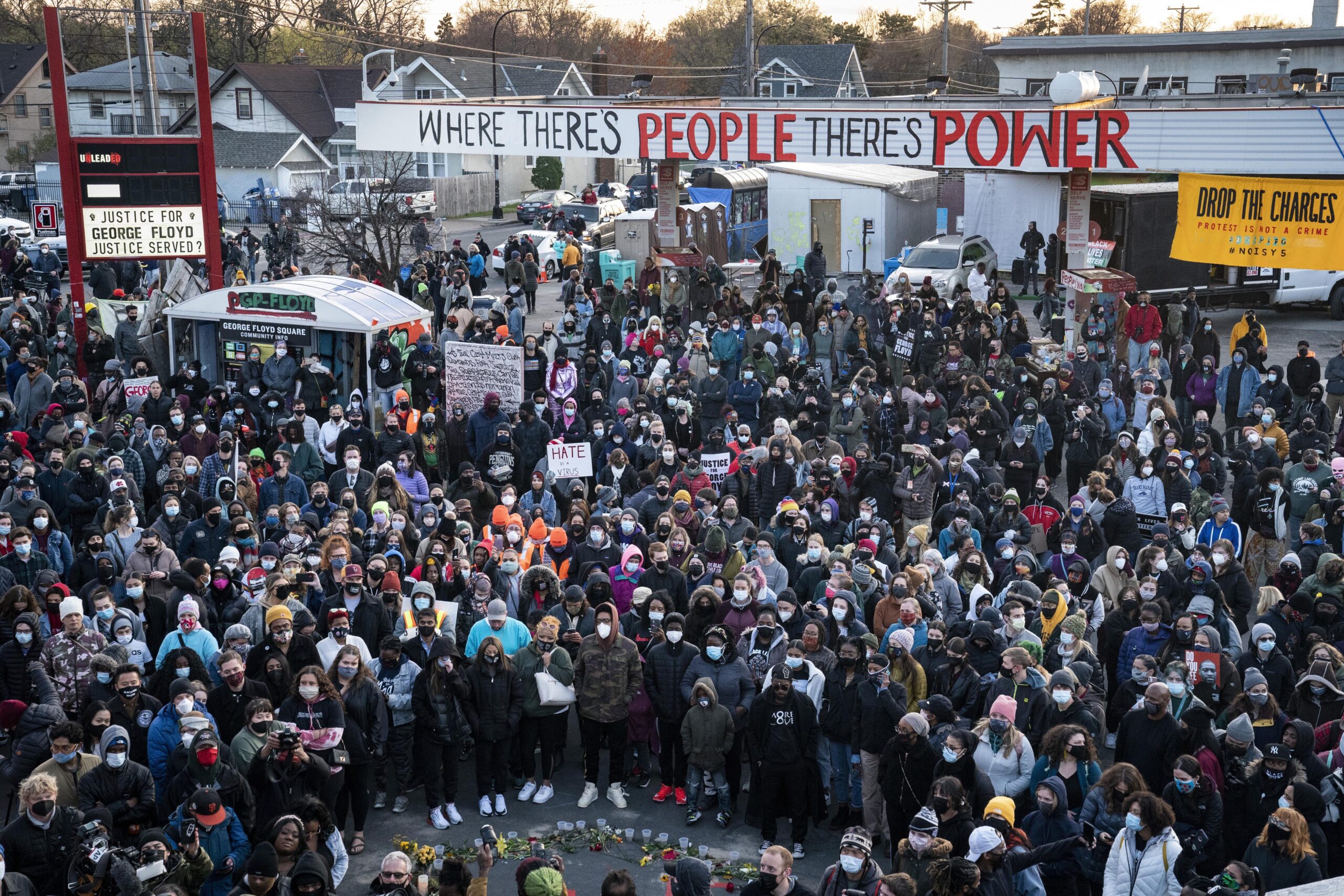
Demonstrators gather outside Cup Foods to celebrate the murder conviction of former Minneapolis police officer Derek Chauvin in the killing of George Floyd, April 20, 2021, in Minneapolis. The third anniversary of Floyd’s murder is May 25, 2023
I’ll never forget the day an editor called me into his office and made a declaration.
“Race no longer matters,” he said.
It was in the wake of the Sept. 11, 2001, terrorist attacks that brought down the twin towers in New York and essentially led the U.S. to launch two of the longest wars in its history in Afghanistan and Iraq. His point was a simple one, that the world had changed forever, what we thought we knew was no longer true, and that we needed to be flexible to adequately meet the moment.
He wasn’t arguing that race no longer actually mattered. He is one of the most thoughtful, well-read people I’ve ever known. He knew — knows — that race will always matter in a country that built an economic and social system on a race-based form of slavery. It was just his way of telling me that a few newsroom initiatives I had been spearheading would be indefinitely postponed. I had spent weeks planning events and talks to help the newsroom better anticipate and grapple with what I saw on the horizon: rising tensions in a country that was rapidly diversifying (and continues to do so) but still led by a mostly white, older generation, and one with a fraught racial history in which pain and pushback have always accompanied progress.
I had spoken to enough demographers to understand what awaited us because there’s no getting around it. Race is the throughline in the evolution of America, and because the U.S. is such a predominate force on the global stage, it is a throughline for the world. But 9/11 was such a powerful event that it overshadowed everything else, and those forward-looking initiatives took a backseat.
More than two decades later, I fear the news industry is making the same mistake. We are now three years out from when the country first saw video of Minnesota police officer Derek Chauvin’s knee on the neck of George Floyd, slowly killing him in broad daylight in front of horrified residents. Floyd’s murder wasn’t another 9/11. It was, though, a spark for one of the largest collective civil rights protests in U.S. history and introspection within the news industry (and beyond).
In 2020, as an industry, we promised to do better and talked about the media’s role in what was supposed to be a national racial reckoning, including improving news coverage that would help us all better understand the root of police violence and other forms of race-based brutality and discrimination. Honestly, I don’t know if we have. It’s hard to gauge because it doesn’t feel as though these efforts are rooted in long-term thinking. Admittedly, it is not an easy task. The Floyd protests and their aftermath unfolded during a pandemic caused by an airborne virus that has killed millions. That same year came the largest one-year spike in homicides. As all this was happening, we had to report on yet another most-important presidential race ever.
Before we could catch our breath after Joe Biden was declared victorious, a violent insurrection on our Capitol forced us to grapple with what it meant and how we had arrived at such a dark moment in our democracy. Not long after, we began to see the assault on trans rights and an enormous increase in the number of book bans and censorship laws being implemented nationwide, largely by conservatives and Republicans. Did I mention that a nearly half-century-old precedent on abortion protection was overturned, all while local news outlets across the country continued to hemorrhage jobs?
Maybe that’s why on the issue of race, the news industry has progressed in fits and starts, even though race has been a critical factor in each of those events. In 2009, there was talk of a post-racial reality because a Black man had been elected president for the first time in our history, which is likely why many of us were slow to recognize the rise of the Tea Party and the anger fomenting underneath it. As a freelancer in the wake of Donald Trump’s victory in 2016, it was hard to get my messages returned by editors who seemed more focused on commissioning yet another piece highlighting Trump fans in rural diners. In contrast, in the wake of Floyd’s murder, I had to turn down jobs because so many offers were coming in. And what ever happened to the supposed industrywide commitment of ensuring that the news industry looks like America?
That’s why I think it a fruitless pursuit to talk about where we are as an industry post-Floyd by pointing to a few stories or investigations. We shouldn’t stop looking into what happened to all those promises made by corporations of all sorts about diversity, equity, and inclusion given that they have largely gone unmet or have been rolled back. What’s happening in the broader corporate world is also happening in the journalism industry as news outlets have been cutting employees leading DEI work first.
And we must grapple with how to deal with the reimplementation of discriminatory policing practices in places like New York City that were curtailed after Floyd’s murder. Police units that had been disbanded for chronic abusive behavior were re-established under Mayor Eric Adams, and a growing number of documented unconstitutional acts have followed. That’s occurring even as we are experiencing of the biggest annual declines in the homicide rate ever recorded.
“Murder is down about 12 percent year-to-date in more than 90 cities that have released data for 2023, compared with data as of the same date in 2022,” Jeff Asher recently wrote in the Atlantic. “Big cities tend to slightly amplify the national trend — a 5 percent decline in murder rates in big cities would likely translate to a smaller decline nationally. But even so, the drop shown in the preliminary data is astonishing.”
Given that race and crime were a major focus of the 2022 midterm elections and likely will be a top issue next year, we can’t afford to get it wrong.
But the real question is this: Do we, as a news industry, have a North Star guiding us on the issue of race? Do we have structures in place that will make us less susceptible to being so derailed by major events that cycle in and out that we forget to keep focused on long-term goals? Are there permanent positions on our staffs dedicated to helping journalists, and the audience at large, better understand race and all the complexities that come with it no matter what else is unfolding? If not, we should not be surprised when it feels difficult, if not impossible, to remain steadfast in our commitments to improve both our newsrooms and our coverage.
There was hope that what was sparked inside newsrooms by the murder of George Floyd would not be easily forgotten. Though the jury is still out, it feels like that hope has already begun to fade.


